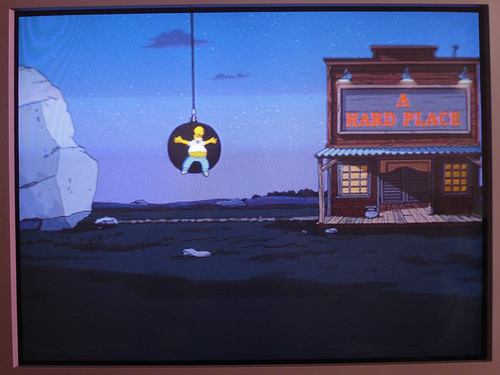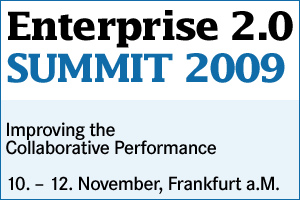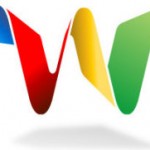Tja, das war eigentlich abzusehen – der neunte WikiWednesday in Stuttgart ging nicht ohne Verluste über die Bühne. Konkret haben wir einen alten Hasen mit der kurzfristigen Ortsänderung – und trotz Umleitungsschildern – verloren in die Irre geführt. Sorry Dirk – tut uns leid. Du hast viel verpasst, das war gestern ein sehr spannendes und gut besuchtes Meeting. Danke an alle Anwesenden und Mitgestalter!
![]()
Zuerst aber ein großer Dank an den Coworking Space Stuttgart, der uns gestern einen Raum, Beamer und auch alles andere zur Verfügung gestellt hat (Kekse!). Bei Flickr gibt es einige Fotos von der Veranstaltung, da sieht man auch dass es schöne Seminarräume im CoWorking Space hat (hint!). Mehrere der Bilder wurden schon während der Veranstaltung bei Google Buzz gepostet – dem Mittelpunkt unserer Diskussion gestern abend.
Unsere Agenda war ja vielfältig – kein Wunder, bereits in der Vergangenheit haben wir immer wieder die Zukunft der Zusammenarbeit und der Wissensarbeit diskutiert. Buzz ist hier (wie auch Wave) nur ein weiterer Schritt in eine Welt in der das Wort Wiki mehr als Verb, denn als Pronomen verwendet wird …
Entsprechend haben wir gestern abend eine Tour durch Buzz unternommen, inklusive Tipps und Tricks:
- wie verbindet man Buzz mit Twitter? oder via DeWitt Clinton, dem man ohnehin mitlesen sollte
- warum es (im Moment) keine gute Idee ist Twitter mit Buzz zu verbinden …
- wie man geschlossene Gruppen verwendet
- wie man die Interaktion von Google Reader mit Buzz am besten gestaltet (und gleichzeitig smart und clever mit den Informationsmassen umgeht)
- wie Blogs heute mit Feeds umgehen sollten, inklusive WordPress-Plugin-Tipps
- und vieles mehr …
Daneben haben wir auch einige Ideen für das WikiCAMP am 6. März 2010 bei der CeBIT gesammelt – diese trage ich noch zusammen und stelle sie dann im Mixxt-Wiki ein …
 Kleine Sünden werden direkt bestraft – nachdem ich gestern nicht nur ein
Kleine Sünden werden direkt bestraft – nachdem ich gestern nicht nur ein  I’m stuck in the midst of conferences and end-of-year-accelerating projects, both adding to the workload (low-quality rock and the hard place picture of Homer ‘course copyrighted by Fox, obviously).
I’m stuck in the midst of conferences and end-of-year-accelerating projects, both adding to the workload (low-quality rock and the hard place picture of Homer ‘course copyrighted by Fox, obviously).
 I assume that the difference is the result of provisioning of some pre-filled waves and an initial stucture – much like scaffolding a wiki this prepared and leveled the playing field, made it easier for new wavers to enter the E20SUMMIT wave space, find their way around and contribute in a meaningful way. That said, it’s probably an insight for our expectations regarding our employee’s readiness and competencies in using innovative collaboration infrastructures – even geeks on the cutting edge of the social web (like BarCampers typically are) aren’t grokking and mastering the new collaboration approaches easily. Scaffolding seems to be an essential element of enabling them (and their much less geeky colleagues). As such it’s a part of the “implementation effort” (in quoting signs because as we’ve learned at the SUMMIT implementation means different things to different people), I collect and systematize under the notions of “kennen-können-wollen-sollen”, ie. “know about it – master it – want it – be obliged (and ordered to)”. Scaffolding supports all four areas, and consequentially enabled the sustainable growth of the E20SUMMIT waves …
I assume that the difference is the result of provisioning of some pre-filled waves and an initial stucture – much like scaffolding a wiki this prepared and leveled the playing field, made it easier for new wavers to enter the E20SUMMIT wave space, find their way around and contribute in a meaningful way. That said, it’s probably an insight for our expectations regarding our employee’s readiness and competencies in using innovative collaboration infrastructures – even geeks on the cutting edge of the social web (like BarCampers typically are) aren’t grokking and mastering the new collaboration approaches easily. Scaffolding seems to be an essential element of enabling them (and their much less geeky colleagues). As such it’s a part of the “implementation effort” (in quoting signs because as we’ve learned at the SUMMIT implementation means different things to different people), I collect and systematize under the notions of “kennen-können-wollen-sollen”, ie. “know about it – master it – want it – be obliged (and ordered to)”. Scaffolding supports all four areas, and consequentially enabled the sustainable growth of the E20SUMMIT waves …